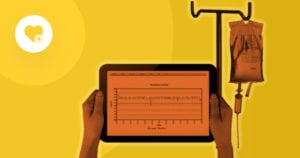
In both manufacturing and the consumer products spaces, the Internet of Things (IoT) enables sensors and devices to collect data about everything from productivity to user interactions. New connected health products that are in development and on the market are expanding these capabilities and collecting data about consumers’ heart rate, physical activity, insulin levels, medication usage, and more. Such connected health data unlocks a wide range of uses for the market as well as the medical field in general.
The popularity of Fitbit and similar wearable fitness trackers have helped consumers become more accustomed to—and even passionate about— the idea of monitoring their health metrics digitally. In some cases, consumers have even been able to use these devices to identify health anomalies and bring them to the attention of doctors for diagnosis of serious medical conditions. Despite our recognition that the general population includes varying degrees of technical knowledge and understanding, when it comes to adoption of new technology, our data indicate that many individuals stand to benefit from receiving potentially life-saving treatment for conditions that might otherwise have gone unnoticed.
Medical device manufacturers also are developing connected health devices that can deliver medical treatment outside the four walls of a hospital or doctor’s office to simplify patient treatment routines and improve therapy. Consider a smart inhaler equipped with a gyroscope and sensor technologies that track not only when the patient takes medicine but how efficiently he or she uses the device. Through wireless connectivity, data is transmitted and collected with an application (app) dashboard that displays information on device orientation and inhalation velocity. These parameters guide the patient toward improved usage and are just a subset of what can be collected in real time.
Others in the industry are experimenting with spectroscopic techniques to measure blood glucose levels in a non-invasive fashion. This market is responding to the growth of diabetes globally, which has become a major challenge for the medical industry and has also been considered by some as the holy grail of modern healthcare technology. Ultimately, a device that can determine the amount of insulin to deliver in a transdermal manner while maintaining portability (in the form of proximity to the patient) is expected to increase significantly the quality of care for managing diabetes.
Beyond the medical benefits, these devices would also track and store the users’ health information. In Jabil’s 2018 Connected Health Technology Trends survey, 97 percent of the surveyed healthcare manufacturing decision makers reported that they plan to collect data in their connected healthcare devices. Slightly more than 50 percent plan to store it in a public cloud infrastructure; 39 percent will store it on a local device, such as a smartphone; 36 percent will use their own infrastructure
Nearly all survey participants agreed that this connected health data will be useful. Nearly half said it can be used to drive general healthcare outcome research, 46 percent said it can be used to provide reports to the users, and 42 percent said the data could be shared with healthcare providers. On the technology side, 53 percent also noted that the data could be used to identify and solve problems with the devices and connectivity, and 49 percent pointed out that the data can help developers understand use models and can guide project development.
1. Dealing with Health Data Overload
As more and more connected healthcare devices hit the market, consumers and these device developers will have the capability to collect more data than ever before. As in other industries, this has brought up concerns about data overload. Although companies might have analysts on staff to help crunch the big data and find meaningful lessons from the numbers, consumers do not usually have that type of support. There’s a strong possibility that they become overwhelmed by the amount of data they receive about themselves. This will lead some to just ignore it because they do not know what data is important and actionable and what is less meaningful.
Application dashboards offer an opportunity to provide summaries of trends and potentially call out metrics that fall outside the normal range. This can help consumers to focus on what data is important. It can also empower them to make quick yet informed decisions about when further professional medical help is required. As companies develop these apps and learn more about user needs through iterative deployment, they should partner with clinicians and medical research groups to help set the normal and abnormal parameters for the various metrics collected. They should also create algorithms that calculate personalized targets or goals for users while presenting the information to them in an intuitive manner. Presentation to the patient becomes crucial since, as noted above, society at large comprises users of all experience levels.
2. Overcoming Security and Privacy Hurdles
Although there are many potential uses for personal healthcare data, there are two large barriers that stand in the way of collection: regulations and privacy. In the US, the Health Insurance Portability and Accountability Act (HIPAA) protects patients’ health information. Its Security Rule requires covered entities that collect and electronically transmit protected health information (PHI) to comply with the following:
- Ensure the confidentiality, integrity, and availability of all e-PHI they create, receive, maintain, or transmit
- Identify and protect against reasonably anticipated threats to the security or integrity of the information
- Protect against reasonably anticipated, impermissible uses or disclosures
- Ensure compliance by their workforce
HIPAA also outlines risk management and information security measures entities should take to safeguard the information.
Ensuring compliance with such strict regulation can be a barrier to entry for many device manufacturers. The key to overcoming this barrier is to find an expert partner in the space. No company can really be master of all, so it’s important to choose the right partners. Amazon Web Services (AWS) is a cloud partner with which we (Jabil) have found success for our healthcare solutions because AWS offers 98 cloud-computing tools that are HIPAA compliant. That compliance makes those tools more secure and ensures that Amazon does not collect any unauthorized personal data or use data for the purposes of creating targeted advertising for the user. Such assurances are vital to building and retaining customers and end users’ trust.
Even though patient data is thoroughly protected by these legal standards, users and caregivers aren’t always ready to trust these devices. Just like smart home devices, they are concerned that connected healthcare devices aren’t secure. This concern is especially important for these types of devices because they deliver lifesaving treatment. If a hacker tampers with a smart home system and turns off lights or adjusts the home’s temperature, the impact usually isn’t life or death. However, with connected healthcare devices, equipment failures or inappropriate dosage adjustments orchestrated by outside parties could be deadly and could potentially affect many patients simultaneously given the scale of healthcare technology solutions.
Consumers are also concerned about data security. In a clinical trial of a smart injector for diabetes patients, a major healthcare company couldn’t recruit enough participation in the trial because of the terms and conditions for the app associated with the smart injector. Our recent survey points out a similar trend: 17 percent of surveyed companies that had pulled back the launch of a connected healthcare product did so because of privacy and data security concerns. This sentiment will likely shift within the next few years as consumers become more and more comfortable with sharing their data with secured devices. To gain that
3. Monetizing Connected Health Data
While privacy concerns and regulations remain at the forefront, it’ll
Still, hackers will pursue these data. TechCrunch reports that medical records remain highly valuable on the black market. In 2017, the healthcare industry saw an average of 32,000 intrusion attacks per organization per day, according to security protection firm FortiGuard Labs. That’s more than twice the amount of attacks received by organizations in other industries. Given that precarious environment, it’s only a matter of time before a major cybersecurity attack breaches millions of medical records. Connected healthcare device manufacturers should think twice about how they are collecting, storing and using consumer data to avoid being the party victimized by a data breach.
As the model for healthcare shifts toward improving outcomes and reducing cost, one way to monetize these solutions after initial purchase would be to offer monthly or annual service plans with the devices and apps. In this way, users or their insurance providers would pay recurring fees to continue to monitor their health or receive treatment in a convenient manner. Whichever approach takes hold, it’ll likely consider the importance of value-based care while providing a means for recovering on remote care management, as opposed to previous traditional patient care programs that have been more transactional.
The data these devices collect also offer the potential to support future breakthroughs in science and medicine through increased collaboration. The pharmaceutical companies behind the connected health devices have the capability to partner with clinicians to analyze aggregate data and identify health trends or to develop early symptom detection. That capability could ultimately lead to accelerated solutions that provide the opportunity to save lives and improve the quality of care for users much sooner than anticipated.
Survey participants point out that the data from these devices also could potentially improve treatments for illnesses, shorten the amount of time from diagnosis to recovery, and improve the total cost of diagnosis and treatment. At the end of the day, the goal of connected healthcare devices is to improve patients’ lives and reduce the burden on the medical system, pursuing another holy grail of improved care at lower cost. Connected health data can help us get there.
Written by Dr. Eddie Kobeda, Director of Strategic Development, Nypro, A Jabil Company.





 Related Podcast Episode
Related Podcast Episode




 Related Applications
Related Applications


 Latest IoT News
Latest IoT News









